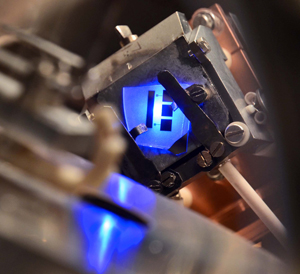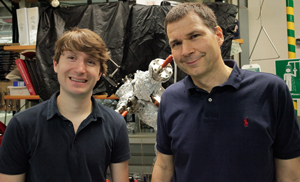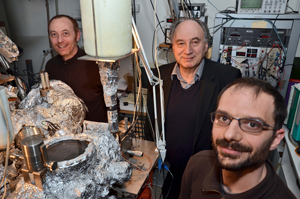Researchers at University of California, Santa Barbara, in collaboration with the école Polytechnique in Paris, France, say that they have identified Auger recombination as the mechanism that causes nitride light-emitting diodes (LEDs) to be less efficient at high drive currents (‘Direct Measurement of Auger Electrons Emitted from a Semiconductor Light-Emitting Diode under Electrical Injection: Identification of the Dominant Mechanism for Efficiency Droop’, be published in Physical Review Letters; a similar version of the accepted manuscript can be found at http://arxiv.org/abs/1304.5469).

Picture: LED emitting light under forward bias in an ultra-high-vacuum chamber allowing simultaneous electron emission energy. (Credit: école Polytechnique, Ph. Lavialle.)
Until now, scientists had only theorized the cause behind the phenomenon of LED ‘droop’ (a drop in light output at higher applied drive current). The high cost per lumen of LEDs has so far held the technology back as a viable replacement for incandescent bulbs for all-purpose commercial and residential lighting. But an explanation of the cause of LED efficiency droop could change this, according to researchers professor James Speck and Claude Weisbuch of the UCSB Center for Energy Efficient Materials, an Energy Frontier Research Center sponsored by the US Department of Energy (DOE) Office of Science.

Picture: Justin Iveland (left) and professor James Speck, UCSB. (Credit: UCSB.)
Knowledge gained from the study is expected to result in new ways of designing LEDs with much higher light emission efficiencies. LEDs have great potential for providing long-lived high-quality efficient sources of lighting for residential and commercial applications. The DOE recently estimated that the widespread replacement of incandescent and fluorescent lights by LEDs in the USA could save electricity equal to the total output of fifty 1GW power plants.
“Rising to this potential has been contingent upon solving the puzzle of LED efficiency droop,” says Speck, professor of Materials and the Seoul Optodevice chair in Solid State Lighting at UCSB. “These findings will enable us to design LEDs that minimize the non-radiative recombination and produce higher light output,” he adds.
“This was a very complex experiment—one that illustrates the benefits of teamwork through both an international collaboration and a DOE Energy Frontier Research Center,” comments Weisbuch, distinguished professor of Materials at UCSB. Weisbuch, who is also a faculty member at the école Polytechnique in Paris, enlisted the support of colleagues Lucio Martinelli and Jacques Peretti. UCSB graduate student Justin Iveland was a key member of the team working both at UCSB and école Polytechnique.

Picture: From left: Jacques Peretti, Claude Weisbuch and Lucio Martinelli. (Credit: école Polytechnique, Ph. Lavialle.)
In 2011, UCSB professor Chris van de Walle and colleagues theorized that the complex non-radiative process of Auger recombination was behind nitride LED droop, whereby injected electrons lose energy to heat by collisions with other electrons rather than emitting light (Emmanouil Kioupakis et al, ‘Indirect Auger recombination as a cause of efficiency droop in nitride light-emitting diodes’, Appl. Phys. Lett., vol98, p161107, 2011).
Speck, Weisbuch and their research team claim that they have now achieved a definitive measurement of Auger recombination in LEDs. The experiment used an LED with a specially prepared surface that allowed the researchers to directly measure the energy spectrum of electrons emitted from the LED. The results unambiguously showed a signature of energetic electrons produced by the Auger process.
The research was funded by the UCSB Center for Energy Efficient Materials. Additional support for the work at école Polytechnique was provided by the French government. The Center for Energy Efficient Materials at UCSB is a research program within the Institute for Energy Efficiency, a cross-campus institute dedicated to science and engineering research for a more efficient sustainable energy future.





